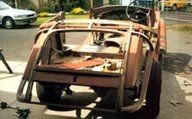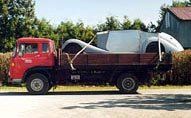A new frame for the old girl
Up to this time I had been assisting with the dismemberment trying to keep track of the bits that had been removed. Now with the rear body tub sitting on a pair of saw horses I could spend several nights patiently chiselling the heads of the pins that hold the alloy body to the wooden frame. It soon became apparent that the whole frame would need to be replaced, and I started to realise I had a problem:

Where on earth would I find a coachbuilder to replace the frame?
During this time I had also been helping Bill Davies and Lois run the museum and tearooms, and by chance one day a visitor arrived at the museum that I remembered meeting when he was working as a boat builder. Colton Kerr was an active 78-year-old with a big smile, a mop of white hair and an interest in vintage and classic cars. Aha! I thought - if anyone knew where I could find a coachbuilder, Colton would. So over I went and asked him if he knew where I could find a coachbuilder. I was surprised when he told me that coach building was his first trade.
Colton was led like a lamb to the carcass of the car. There followed much shaking of heads and it began to look as though things were pretty serious. Colton said it was a big job, and he regretfully declined, saying it was too much at his time of life. Oh dear - now where to?
Later the next day there was a ring "Colton here, I've been thinking? It will be a bit of a challenge but I think I'll give it a go!" And so Colton Kerr joined the band of helpers, eventually contributing way beyond his years.
Now I had to get the frame around to Colton's workshop where he had a false floor built and work could start. I loaded the frame onto a trailer and started a very slow trip to Colton's shed. The frame was so bad that bits kept falling off in transit. Once we arrived at the shed what was left of the frame was centred on the jig ready for work to begin.
A year previously, I had researched timber to replace any frames and had initially started with Tanekaha as a replacement for the English Ash originally used. Following advice from an old builder mate I looked into a timber called Puketea and found it was an extremely strong swamp wood that resisted rot, was very easy to work with and was incredibly light - almost like balsa. I located a big billet of timber in Matamata and reached agreement to buy this and transport it to Tauranga, where it was broken down and taken around to Colton's shed. This became the basis of the new frame that Colton built patiently, piece by piece. The rear wheel arches were made of laminated marine plywood built up over a jig and the door posts were made from mature tanalised pine - both of these materials considerably stronger and longer lasting than the original Ash.

During the course of construction it was found that the body was out of plumb and one door was longer than the other. Colton corrected both of these faults and eventually a new frame was finished. It was then returned to the museum to be reunited with the chassis.
During this time, Steve had been patiently working away rebuilding and repainting the chassis, replacing shackles, checking the steering box and a host of other items that all took up his time. We now had a painted and reconditioned chassis ready to meet the new frame, and with a little bit of easing they were finally reunited.
So now we had a rolling chassis with the rear frame bolted on and ready to have the alloy skin reattached, but we still had to take out the ding in the left quarter. But first of all we had to remove all the old paint. We tried paint stripper but found it wouldn't even soften the old paint, which was really tough. We ended up grinding it off with a disk grinder, using a lot of disks in doing so!

Welding and panel beating alloy is quite different to panelsteel and it took a bit of time to get it right. Finally it was acceptable and we started to reattach the skin using small brass flat head nails. Now the doors were stripped of their skin and the frames strengthened using panelsteel braces at all joints, adding timber where the door had to be increased in size to correct the problem Colton had found. (Little did we realise the effect of this later on when we were fitting the hood braces.) To make the doors the same size meant new door skins in alloy, wheeled to the correct profile. A little bit of easing here and there, and before too long we had two doors that swung on the rear tub doorposts.
The front scuttle frame was in good condition and only about four pieces of timber were replaced. Many of these cars suffered from the dreaded scuttle shake and to try to remove this we re-glued all joints with resamex and attached steel braces to all the joints. The outer skin was reattached and the scuttle was as firm as a rock. Now we had to attach the four guards, and suddenly it was starting to look like a real car.
Steve the panel beater had recommended that we take the car up to Snells Beach, about 70km north of Auckland, to a painter he knew there to level the car and get it ready for painting. So, borrowing Phil Boyd's truck, he set off. It was the last I was to see of the car for two months.






